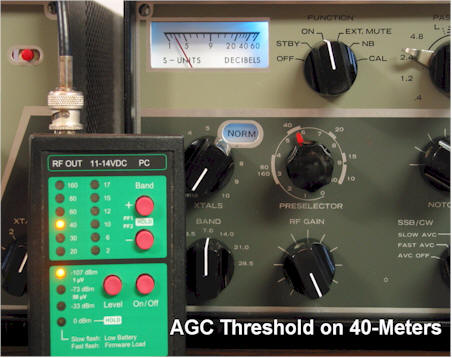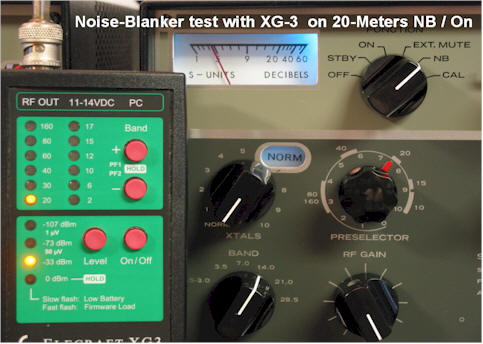|
A Crystal Range Solution for the Drake 4-Line Gear By: Jeff Covelli, WA8SAJ, wa8saj@ncweb.com The
thought of having to add crystals to a Drake 4-Line receiver for extra frequency
coverage from 1.5 MHz to 30 MHZ besides the five crystals i
Solution: Figure 2: While I was using my Elecraft® XG-3 signal generator one day, I thought this could be used in place of crystals for my R-4B receiver, so I set out to see if it would work. The Elecraft® XG-3 is priced at $179 assembled not a kit and is a self contained signal source with four selectable levels of output starting from 0 dBm, -33 dBm, -73 dBm, and -107 dBm. There are 12 preset frequencies from 1.5 MHz to 200MHz - Harmonics up to 1400 MHz in 1 Hz tuning steps that can be programmed using a computer (RS-232 cable provided). The output is a very stable square wave and enough drive (0 dBm) for the R-4B or any 4-line receiver or transmitter. Now you're going to ask, are these square waves full of harmonics? You would be correct , there are but the R-4B uses very Hi-Q tuned circuits in the pre-mixer stage so the harmonics are not passed on for this application. The R.F. drive level needs to be around 0 dBm and you have to use an external power supply 11 to 14 VDC @60 mA if your using the 0 dBm output, since it will run the internal 9-volt battery down in short order. Putting it to Work: In Figure 3: I made up a short cable of RG-174 (50 ohm) with an old crystal holder taken apart and put a hole on top for the coax cable to come out and then installed an RCA connector with a BNC adapter for the XG-3. NOTE: Drake recommends if using the FS-4 synthesizer, they advise to unplug the FS-4 when not in use if you're using the internal crystals. If you decide to use the FS-4, then you should use it for all the frequencies and don't mix them.
The FS-4 does generate some noise and can cause problems when plugged in and mixed with the crystals. I found this also using the Elecraft™ XG-3, so I decided to program all of the standard crystal frequencies along with the extra ones I needed for the added bands. The crystal frequency range needed for the 4-line is 12.6 MHz to 40.6 MHz. Figure 4: The front panel of the XG-3 has the pre-set frequency bands labeled, but you can use a Brother™ P-Touch® label maker and cover these with what ever you decide to use. I set up my Drake B-line to test out the entire system using the XG-3 along with the RIGOL™ DSA-815T/G spectrum analyzer to look at the R.F. output on all bands for harmonics, spurs etc and found nothing out of specs. As seen in Figure 5 & 6: (10-meter example) the harmonics were exactly the same for all the bands 1.5 to 30 MHz using the receiver or transmitter with the XG-3 or crystals. One note on using split operations, if you're going to try and split, then you will need to come up with a switching arrangement so the XG-3 can drive both separately.
I found some additional back ground noise in the R-4B receiver on the higher bands using the XG-3 and this is due to the drive I used at first (0 dBm), then I added some attenuation 3dB to 6 dB and most of it went away and still drove the receiver and transmitter with no ill effects. I found that the frequencies programmed worked perfect and were very stable as checked with an IFR-1200S service monitor in zero beat function, no pulling under load or wiggling frequency when transmitting at 120 watts output using the Drake T-4XB transmitter and having the R-4B receiver controlling the frequency in transceive mode. I also ran high power using the Drake L-4B developing 1 KW output and it did not affect the XG-3 when tied to an antenna on all bands. So the XG-3 seems to be immune to heavy R.F. even though it is in a plastic housing. I was able to program many SWL frequency bands and enjoyed doing this without having to buy a crystal at $25 for each 500 kHz band! Other Features:
Now there are more handy uses. As stated before, this is a signal generator and
you can check your receiver sensitivity for AGC threshold, S-9 meter reading and
frequency calibration. See Figure 7 on 40-meters the AGC threshold is at 1 UV.
Of course you will have to use the standard crystals installed for the normal
ham bands to do this, but there is more. The XG-3 has a sweep function, so you
can
One note on using the XG-3 there is a fusible trace inside to protect it from burning up, so no high voltage or excessive RF can be tied to the BNC connector, Don't try using this with any D.C. or RF voltages that are very high. I did try and use the XG-3 on a Collins S-line and it did not work very well even though I isolated the XG-3 on both center connector and outside shield, there was not enough drive anyway (darn).
Closing Notes: I know this is a modern addition to the boat anchors (older gear), but thought it might be of interest for someone wanting to listen to other ham-bands and SWL bands without having to spend a lot of money and also have a piece of test equipment at a moderate cost and it is currently manufactured in the U.S.A. References:
Author Contact Info: Jeff Covelli, WA8SAJ, 5368 Melody Lane, Willoughby, Oh 44094, wa8saj@ncweb.com
|
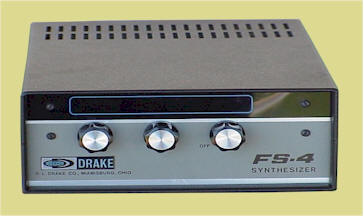 nstalled
by the factory could break the bank. The Drake 4-Line series have 10 to 15 slots
for additional
500 kHz frequency ranges and with the cost of crystals today being around $25
each, this could get expensive $250 to
$375 for the 10 to 15 extra frequency ranges. If you were to add up all the
extra crystals for the entire 1.5 MHz to 30 MHz
frequency range, there are a total of 50 crystals having a cost of $1250. The
new crystals are excellent quality and are cut exactly for Drake and work very
well from International Crystal Co. Inc®, but again the cost is high for
general-coverage. Figure 1: Another way to add extra frequency
ranges is to purchase a used Drake FS-4 frequency synthesizer that Drake
manufactured and plugs into the 4-line series which gives you a signal source
for each 500 kHz range with a nice matching cabinet and a set of rotary switches
for a direct readout of each frequency range. Now the FS-4 is great and works
fine, but the used price is around $500 or more. It is a bit expensive and very
hard to find working correctly. Many of these have been twiddled with so much
the tiny iron cores for alignment are worn out or not all working on all 500 kHz
frequency ranges.
nstalled
by the factory could break the bank. The Drake 4-Line series have 10 to 15 slots
for additional
500 kHz frequency ranges and with the cost of crystals today being around $25
each, this could get expensive $250 to
$375 for the 10 to 15 extra frequency ranges. If you were to add up all the
extra crystals for the entire 1.5 MHz to 30 MHz
frequency range, there are a total of 50 crystals having a cost of $1250. The
new crystals are excellent quality and are cut exactly for Drake and work very
well from International Crystal Co. Inc®, but again the cost is high for
general-coverage. Figure 1: Another way to add extra frequency
ranges is to purchase a used Drake FS-4 frequency synthesizer that Drake
manufactured and plugs into the 4-line series which gives you a signal source
for each 500 kHz range with a nice matching cabinet and a set of rotary switches
for a direct readout of each frequency range. Now the FS-4 is great and works
fine, but the used price is around $500 or more. It is a bit expensive and very
hard to find working correctly. Many of these have been twiddled with so much
the tiny iron cores for alignment are worn out or not all working on all 500 kHz
frequency ranges.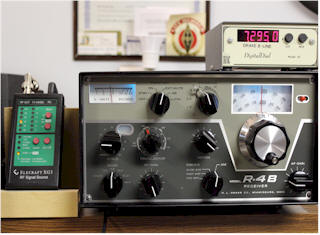
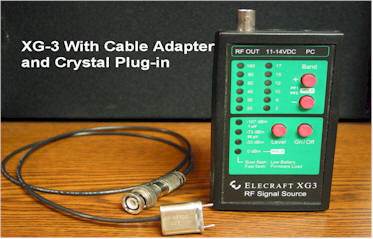
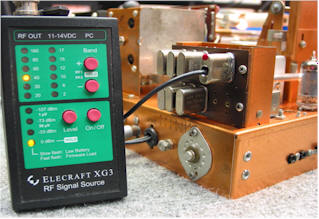
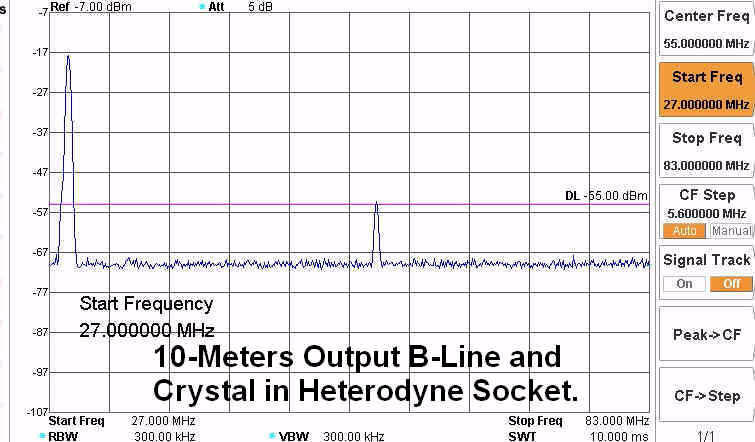
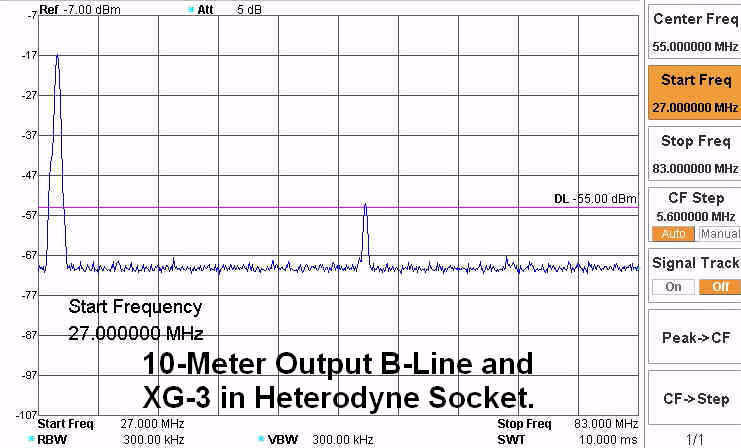
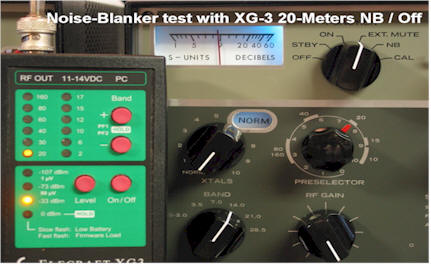 actually
use it to sweep a filter from 1.5 to 1400 MHz or use it to sweep at a very short
time span to check the noise-blanker. There are two programmable functions (PF1
& PF2) on the front panel you can pre-set for this function. I have mine set for
the 20 and 40-meter bands to check noise-blankers and these are the best bands
to do this. See Figure 8 & 9 you can pre-set the frequency, drive level and time
span using the program provided, now you can see the noise-blanker working by
looking at the S-meter drop by 4 to 5 S-units (30 dB).
actually
use it to sweep a filter from 1.5 to 1400 MHz or use it to sweep at a very short
time span to check the noise-blanker. There are two programmable functions (PF1
& PF2) on the front panel you can pre-set for this function. I have mine set for
the 20 and 40-meter bands to check noise-blankers and these are the best bands
to do this. See Figure 8 & 9 you can pre-set the frequency, drive level and time
span using the program provided, now you can see the noise-blanker working by
looking at the S-meter drop by 4 to 5 S-units (30 dB).